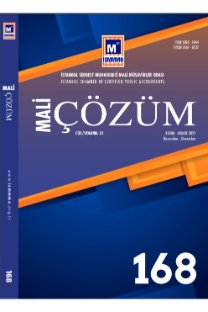KÜÇÜK VE MİKRO İŞLETMELER İÇİN FİNANSAL RAPORLAMA STANDARTLARI (KÜMİ FRS) ÇERÇEVESİNDE MADDİ DURAN VARLIKLARIN MUHASEBELEŞTİRİLMESİ
Küçük ve Mikro İşletmeler İçin Finansal Raporlama Standartları (KÜMİ FRS) 2019 yılında Kamu Gözetimi Muhasebe ve Denetim Standartları Kurumu (KGK) tarafından taslak olarak yayınlanmıştır. Taslak yürürlüğe girdiğinde uygulayacak işletme sayısı açısından en geniş kapsamlı muhasebe standardı olacaktır. Bağımsız denetime tabi olmayan küçük ve mikro işletmeler halihazırda Muhasebe Sistemi Uygulama Genel Tebliğine (MSUGT) ve Vergi Usul Kanunu (VUK)’a göre muhasebe kayıtlarını yapmaktadır. Ancak VUK ‘ta değerleme hükümlerinin yer almaması, amortisman, reeskont ve kıdem tazminatı gibi bazı uygulamaların zorunlu olmayıp işletmenin isteğine bırakılması, hazırlanan finansal tabloların gerçeğe uygun ve karşılaştırılabilir bilgiler sunmasını engellemektedir. Bu nedenle ülkemizde KÜMİ FRS’ye ihtiyaç duyulmuştur. Toplamda 22 bölümden oluşan standartta maddi duran varlıklar (MDV) 11. bölümde bulunmaktadır. Çalışmanın konusunu oluşturan MDV işletmelerin faaliyetlerin yürütülmesi noktasında en önemli varlık kalemlerinden birini oluşturmaktadır. Bu doğrultuda amaçlanan, KÜMİ FRS kapsamında maddi duran varlıkların muhasebeleştirilmesinde sektör uygulayıcılarına yol göstermektir. Çalışmada öncelikle maddi duran varlıklar açısından yürürlükteki uygulamalarla KÜMİ FRS arasındaki benzerlik ve farklılıklar ortaya konmuştur. Ardından KÜMİ FRS kapsamında yapılması gereken muhasebe kayıtları örneklerle gösterilmiştir.
ACCOUNTING OF TANGIBLE ASSETS IN THE FRAMEWORK OF FINANCIAL REPORTING STANDARDS FOR SMALL AND MICRO ENTERPRISES (SME FRS)
Financial Reporting Standards for Small and Micro Enterprises (SME FRS) was published in 2019 as a draft text by the Public Oversight Accounting and Auditing Standards Authority. When the draft comes into force, it will be the most comprehensive accounting standard in terms of the number of businesses. Small and micro enterprises that are not subject to independent audit are currently making their accounting records according to the General Communique on Accounting System Application (GCASA) and Tax Procedure Law (TPL) . However, the absence of valuation methods in TPL, depreciation, rediscount and severance payment are not compulsory and left to the request of the company, preventing the prepared financial statements from providing fair and comparable information. For this reason, SME FRS was needed in our country. In the standard consisting of 22 sections in total, there are tangible assets in section 11. The tangible assets that constitute the subject of the study constitute one of the most important asset items of the enterprises in terms of carrying out the activities. The aim is to guide industry practitioners in accounting for tangible assets under the SME FRS. In the study, the similarities and differences between the current practices and the SME FRS are revealed in terms of tangible assets. Then, accounting transactions to be made within the scope of SME FRS are shown with examples.
___
- Gökçen, G., Öztürk, E. ve Güleç, Ö. F. (2019). KÜMİ FRS Seti Taslağı, BOBİ FRS Seti ve Tam Set TMS/TFRS’nin Temel konular Açısından Karşılaştırılması. Finans Ekonomi ve Sosyal Araştırmalar Dergisi, 4(3), 413-430.
- Gücenme Gençoğlu, Ü. (2020). Küçük ve Mikro İşletmeler İçin Finansal Raporlama Standardı Taslağı’nın BOBİ FRS ve Vergi Uygulamalarımız ile Karşılaştırılması ve Genel Değerlendirme. Business and Economics Research Journal, 11(1), 187-199.
- Kamu Gözetimi Muhasebe ve Denetim Standartları Kurumu. (2017). Büyük ve Orta Boy İşletmeler İçin Finansal Raporlama Standardı. Erişim Adresi: www.kgk.gov.tr/ Erişim Tarihi: 02.04.2020.
- Kamu Gözetimi Muhasebe ve Denetim Standartları Kurumu. (2018). 13.09.2018 Tarihli ve 03/161 Sayılı Kurul Kararı . Erişim Adresi: www.kgk. gov.tr/ Erişim Tarihi: 09.09.2020.
- Kamu Gözetimi Muhasebe ve Denetim Standartları Kurumu. (2019). Küçük ve Mikro İşletmeler İçin Finansal Raporlama Standardı Taslağı. Erişim Adresi: www.kgk.gov.tr/ Erişim Tarihi: 10.04.2020.
- Kamu Gözetimi Muhasebe ve Denetim Standartları Kurumu. (2020). Türkiye Muhasebe ve Türkiye Finansal Raporlama Standartları 2020 Seti. Erişim Adresi: www.kgk.gov.tr/ Erişim Tarihi: 24.03.2020.
- Kıymetli Şen, İ. ve Özbirecikli, M. (2020). KÜMİ FRS’nin İş Dünyasına Sağlayabileceği Yararlar: BOBİ FRS, TMS/TFRS ve Mevcut Muhasebe Sistemiyle Mukayeseli Bir İnceleme. Muhasebe Bilim Dünyası Dergisi, 22, 1-19.
- Maliye Bakanlığı (26.12.1992). 1 Sıra Nolu Muhasebe Sistemi Uygulama Genel Tebliği. Ankara: Resmi Gazete (21447 Sayılı).
- Sağlam, N., Yolcu M. ve Eflatun A. O. (2017). Örneklerle UFRS Kayıtları. Bursa: MuhasebeTR.
- Tutkavul, K. (2020). TMS, BOBİ FRS, KÜMİ FRS ve VUK Perspektifinden Dönüştürme Maliyetleri: Üretim Maliyetlerine ve Vergilendirmeye Etkisi. Pamukkale Üniversitesi Sosyal Bilimler Enstitüsü Dergisi, 40, 347-365.
- ISSN: 1303-5444
- Yayın Aralığı: Yılda 6 Sayı
- Başlangıç: 1991
- Yayıncı: İstanbul Serbest Muhasebeci Mali Müşavirler Odası
Sayıdaki Diğer Makaleler
GÜVENİN VERGİ AHLAKI ÜZERİNDEKİ ETKİSİ: ÜLKELER ARASI BİR ARAŞTIRMA
DEFTER BEYAN SİSTEMİ UYGULAMASININ SORUNLARI ÜZERİNE TRABZON İLİNDE BİR ARAŞTIRMA
Abdülkadir PEHLİVAN, Yasin AKKAYA
İSTANBUL BÜYÜKŞEHİR BELEDİYESİ 2021 KONSOLİDE BÜTÇESİ’NE BAKIŞ
SİPARİŞ ÜZERİNE YAPILAN AR-GE PROJELERİ VE MUHASEBE SÜRECİNİN İNCELENMESİ
KAMU ALACAKLARININ KORUNMASINDA TEMİNAT MÜESSESİNİN İNCELENMESİ VE DEĞERLENDİRİLMESİ
FİNANSAL VE FİNANSAL OLMAYAN RAPORLAMADA GÜNCEL TARTIŞMALAR: İŞ MODELİ TEMELLİ MUHASEBE YAKLAŞIMI
KIDEM TAZMİNATINA HAK KAZANDIRAN İSTİSNAİ İSTİFA HÂLLERİNDE YAPILAN FESİH İŞLEMİNİN HUKUKİ NİTELİĞİ
